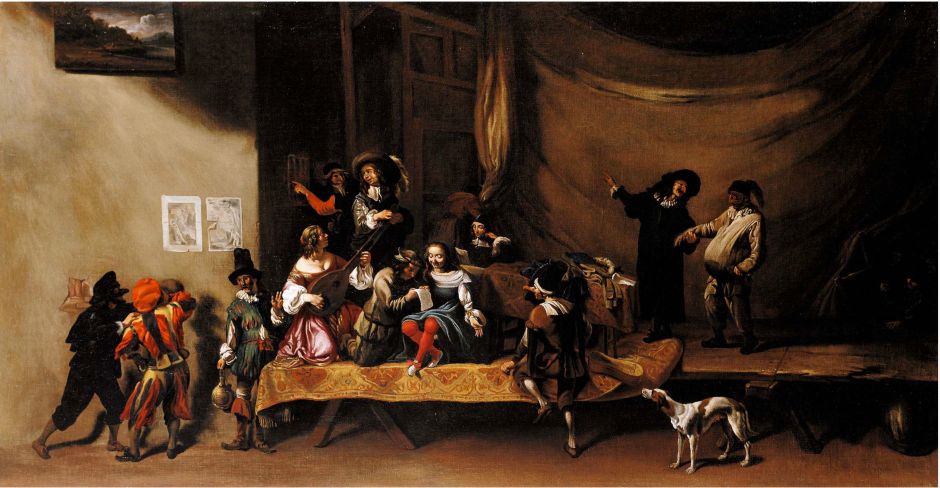Clowns, fools and jesters might appear related species, but they come from quite different traditions, and have separate readings. While jesters and fools were intended to add a little light humour to royal courts, clowns originated in the theatre of the mid-sixteenth century, in what soon became known as the commedia dell’arte, also Italian comedy in English.
This comedy theatre relied on a mixture of improvisation, stereotype characters, and prepared jokes. It has long been popular in the Venice Carnival, and spread throughout much of Europe during the seventeenth and eighteenth centuries, when it peaked. Among its best-known characters are:
- Harlequin (Arlecchino), a servant wearing colourful jacket and trousers,
- Pulcinella, a servant wearing a baggy white outfit,
- Pantalone, an older wealthy man wearing a dark cape and red trousers,
- Colombine (Colombina), a maidservant wearing either black and white, or similar colourful dress to Harlequin,
- Pierrot, a servant and sad clown, wearing a voluminous white costume with large buttons.
These became increasingly stereotypical over time.

Michelangelo Cerquozzi’s Rehearsal, or A Scene from the Commedia dell’Arte from 1630-40 is an early record, in which the costumes are more traditional. At the left is a small group containing Scaramouche, Harlequin and possibly Brighella, and at the right is the Doctor and Pierrot, perhaps.

Antoine Watteau had a particular affection for the commedia dell’arte. The Foursome, from about 1713, marks his return to this theme, with the Pierrot figure standing with his back to the viewer.

In his fête galante, Pleasures of Love from about 1718-19, Watteau brings together his novel sub-genre with a Pierrot figure playing a guitar to serenade the ladies in the foreground.

Watteau’s Italian Comedians from about 1720 shows five figures who have just finished performing in a park on the outskirts of Paris. Pierrot, in his baggy white suit, holds his hat out for donations from the audience. Brighella wears a green-gold suit and cape, and Mezzetin plays his guitar while Harlequin peers over his shoulder. At the far right is Scaramouche, in a Spanish costume of black with a white ruff.

From the same time, and under the same title, Watteau’s stage scene of Italian Comedians puts Pierrot centre-stage, and marked the artist’s last performance of this theme.

At the end of the eighteenth century, Francisco Goya recorded this troupe of itinerant Strolling Players (1793) on the bank of the River Manzanares in Madrid, with a packed audience behind its stage. At the left is Harlequin, with a grubby Pierrot further towards the centre.
Costumes from the commedia also became popular wear to masked balls.

If the story behind Gérôme’s Duel After the Ball (1857) is to be believed, on leaving a masked (fancy dress) ball in the winter of 1856-7, an elected official and a former police commissioner fought a duel in a copse in the Bois de Boulogne, Paris. One was dressed as Pierrot, the other as Harlequin. Pierrot was wounded as a result, and the incident became notorious because of the personalities involved, and their comic costumes.
Pierrot leans, as white as his costume, collapsed against one of his team, his face suggesting shock if not imminent death from a wound bleeding onto his chest. His limp right arm still bears his sword, which now drags on the ground. Two other friends are visibly distressed at his condition and trying to console him.
Harlequin, with his second, walks off into the distance at the right. His sword is abandoned on the snowy ground, near four feathers which have dropped from the American Indian headdress of his second. In the murky distance there is a hackney cab, ready to take the combatants away, and a couple walking along the edge of the copse.
Gérôme stages this theatrically, with the absurd grim humour of the participants’ costumes and the comedy of Pierrot and Harlequin.
The commedia also mutated into what became known as Punch and Judy, first performed by itinerant players.

Philip Hermogenes Calderon’s French Peasants Finding their Stolen Child (1859) draws on the troubled lives of those players. Various characters from a popular street theatre play are seen at the side of their stage. A couple are embracing a young girl, with the girl’s apparent mother kissing her somewhat reluctant daughter on the cheek.
In the background are the audience, and other stalls of a travelling fair. Entertainers in such fairs were vulnerable to crimes such as child abduction, or it may be that the couple and their daughter aren’t part of the fair, but local people who had their daughter abducted by travelling performers.

Honoré Daumier’s The Parade, or Street Circus from about 1860 shows a group of mountebanks, theatrical performers, musicians, and clowns who drew large crowds. The crocodile suggests it may be one of the Pulcinello or Punch and Judy shows which had became popular across France and North America.

